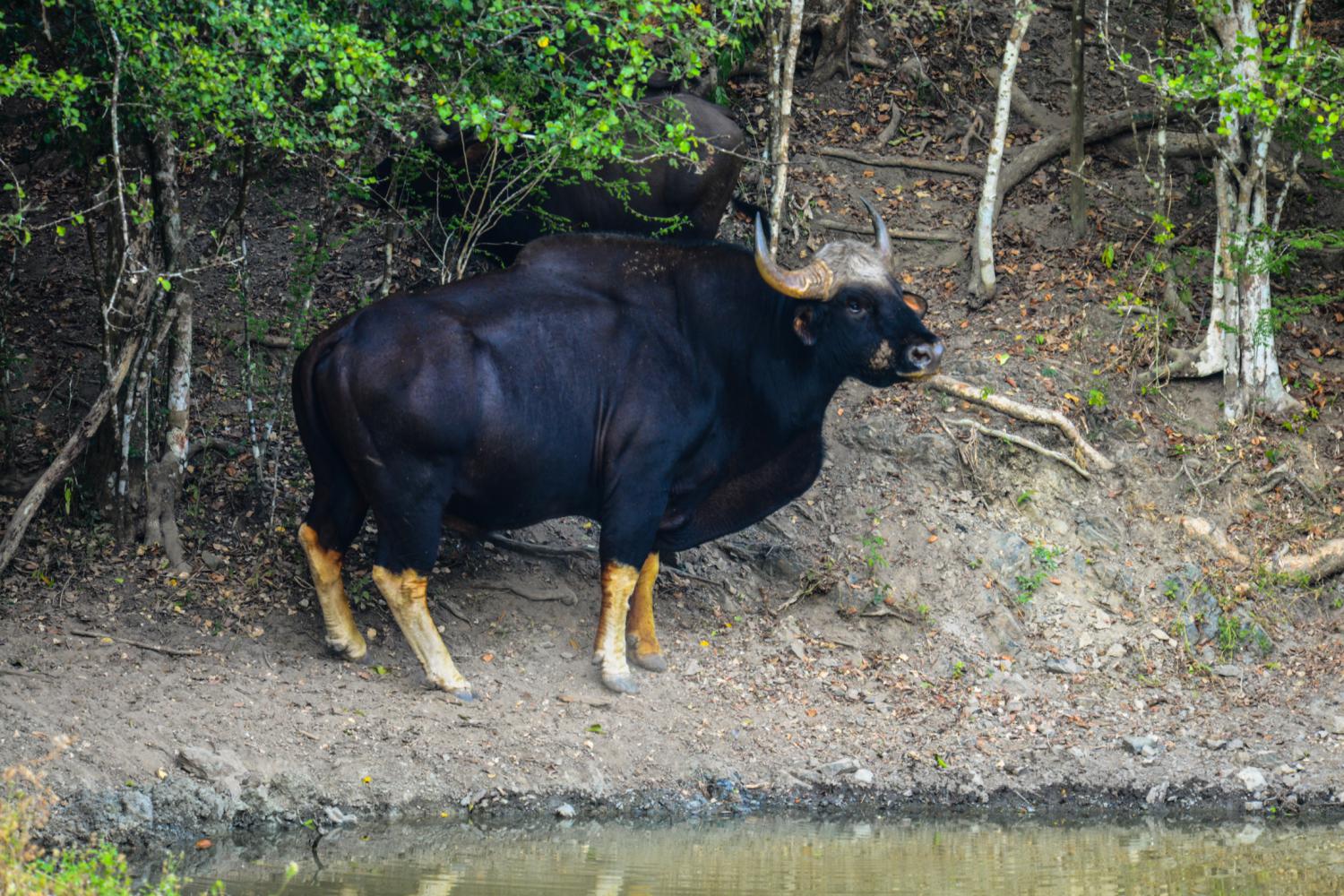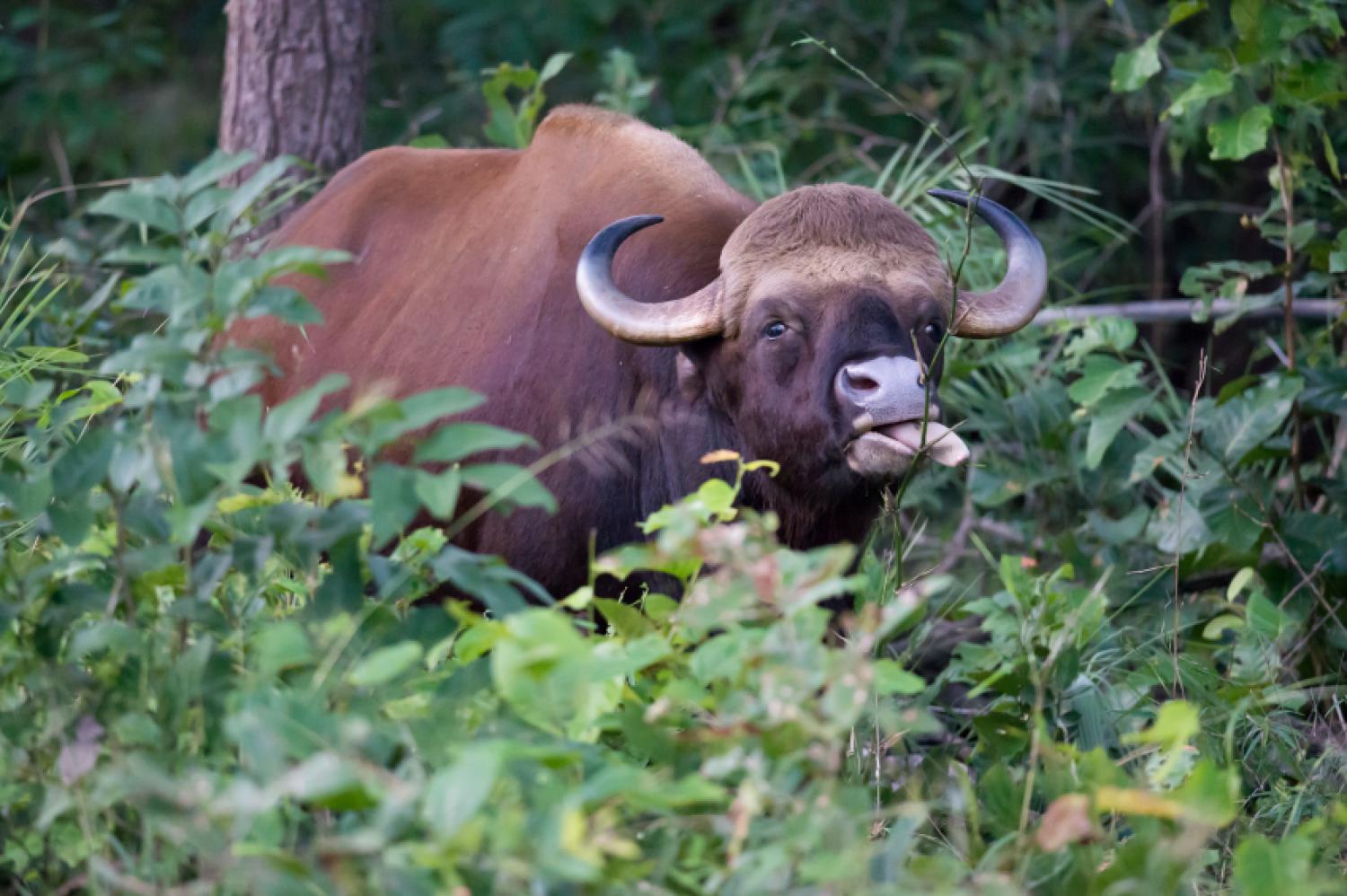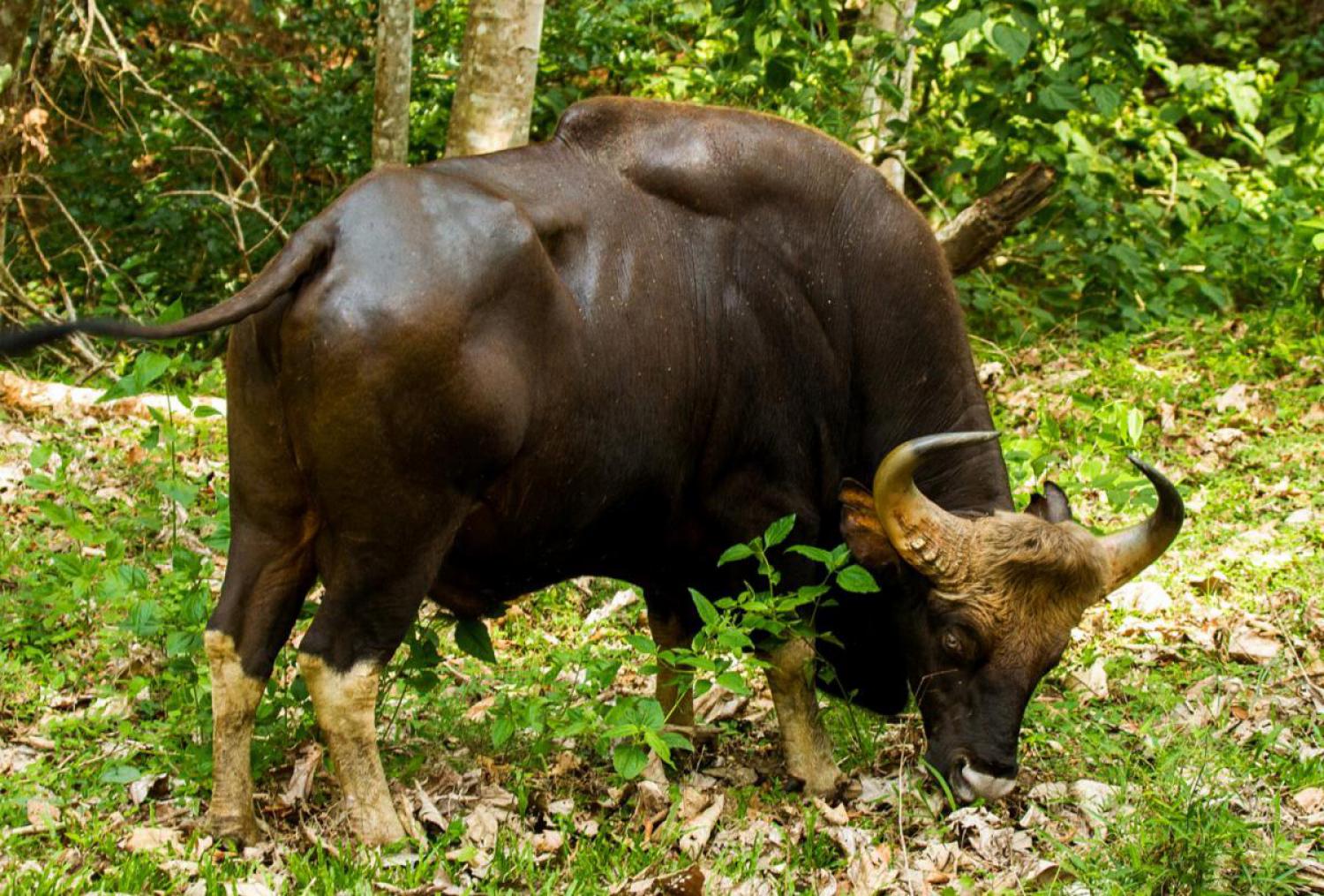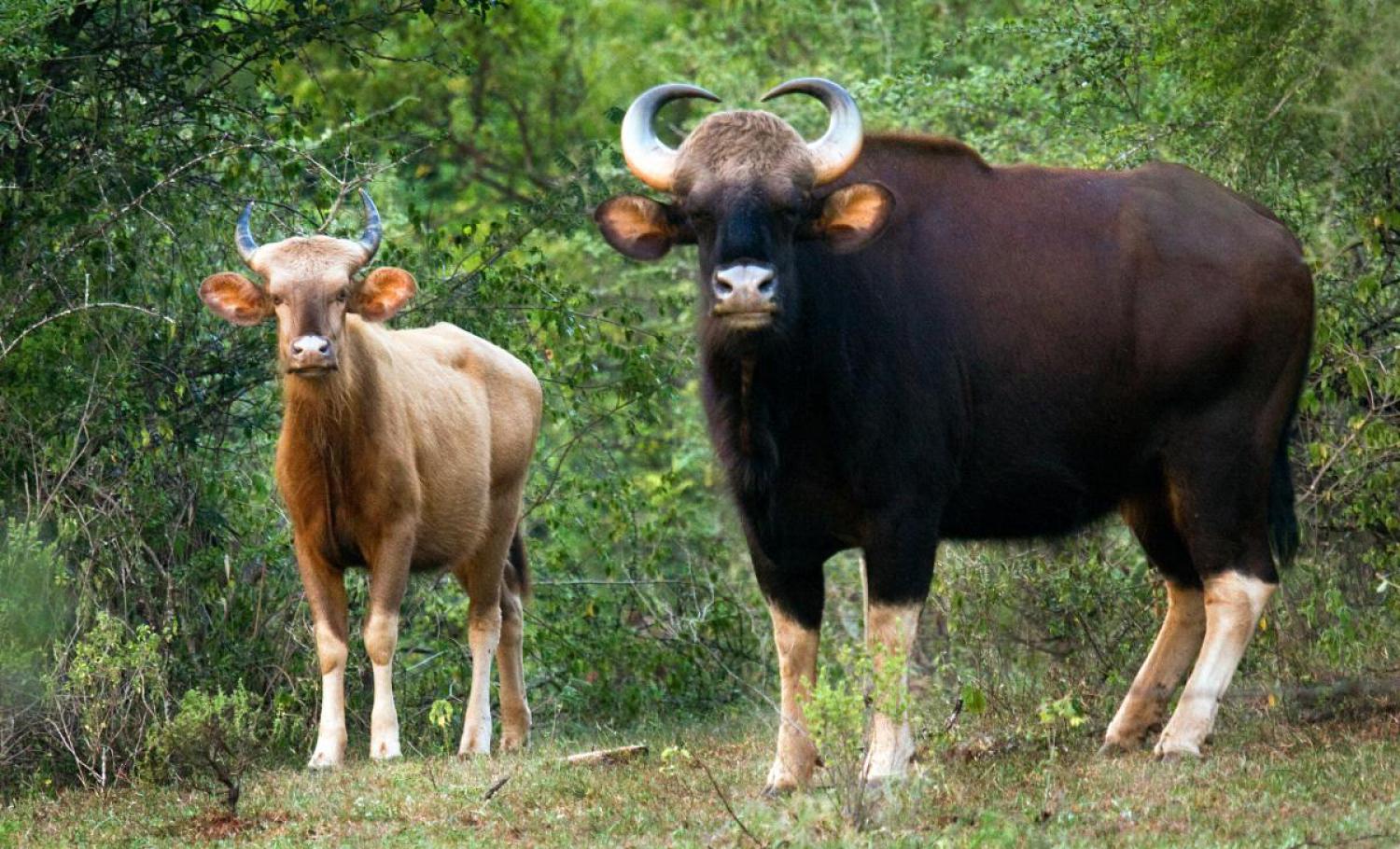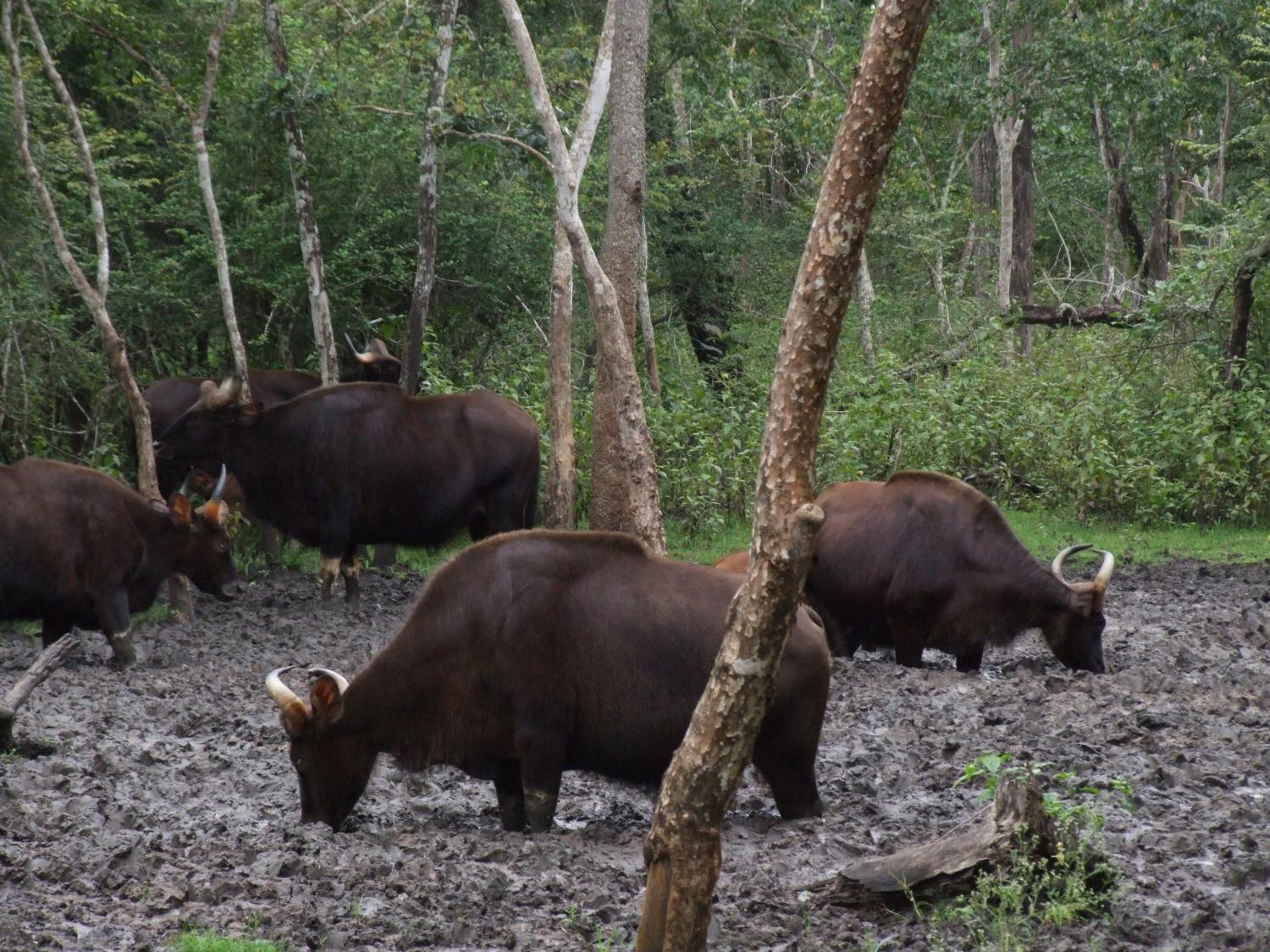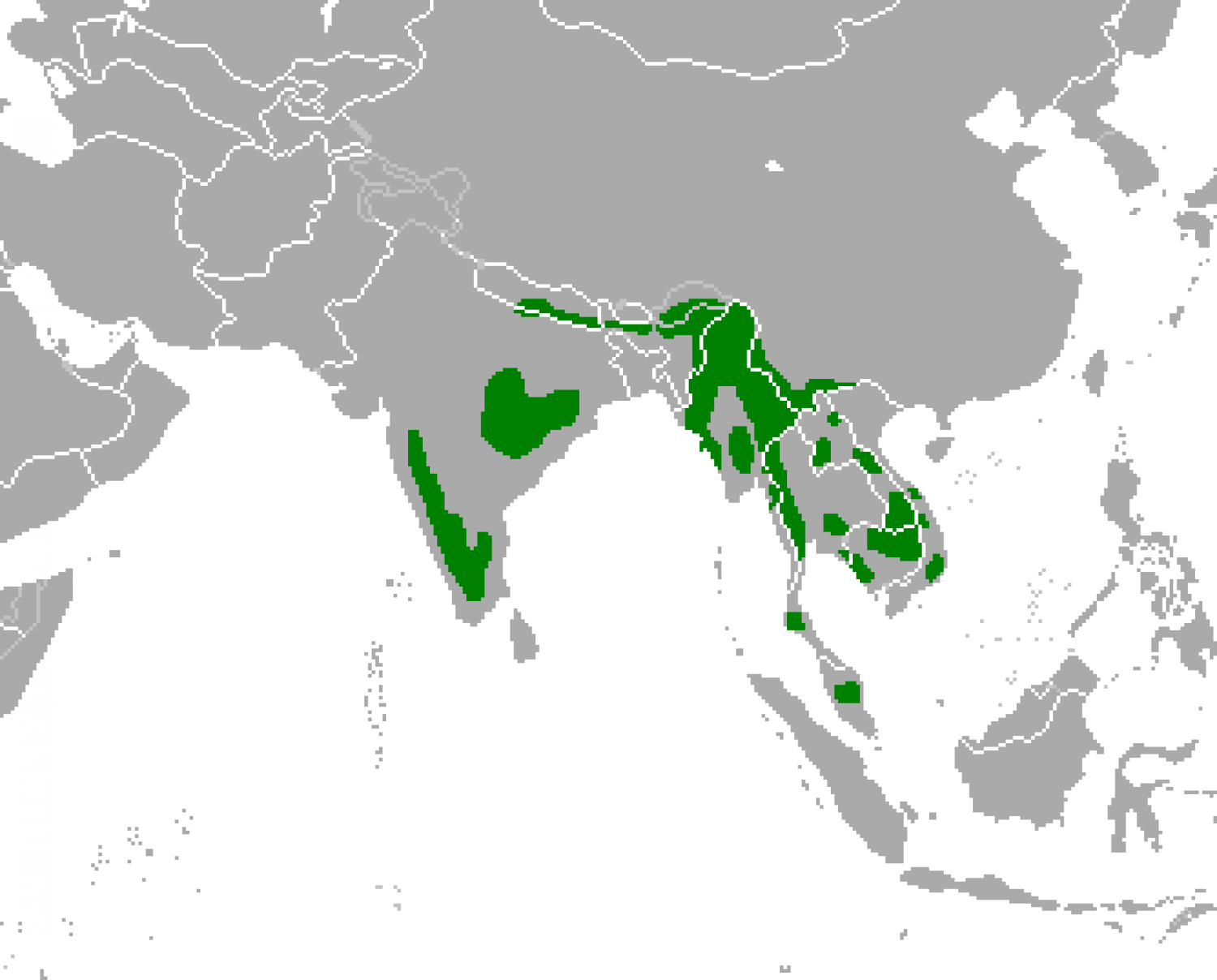Species of Thailand
Gaur
Bos gaurus
(Charles Hamilton Smith, 1827)
In Thai: กระทิง, grating
The gaur (, Bos gaurus), also called Indian bison, is the largest extant bovine, native to South Asia and Southeast Asia. The species is listed as vulnerable on the IUCN Red List since 1986, as the population decline in parts of the species' range is likely to be well over 70% during the last three generations. Population trends are stable in well-protected areas, and are rebuilding in a few areas which had been neglected.
The gaur is the tallest species of wild cattle.
The Malayan gaur is called seladang, and the Burmese gaur is called pyoung .
The domesticated form of the gaur Bos frontalis is called gayal or mithun.
Characteristics
The gaur is a strong and massively built species with a high convex ridge on the forehead between the horns, which bends forward, causing a deep hollow in the profile of the upper part of the head. There is a prominent ridge on the back. The ears are very large; the tail only just reaches the hocks, and in old bulls the hair becomes very thin on the back. In colour, the adult male gaur is dark brown, approaching black in very old individuals; the upper part of the head, from above the eyes to the nape of the neck, is, however, ashy grey, or occasionally dirty white; the muzzle is pale coloured, and the lower part of the legs are pure white or tan. The cows and young bulls are paler, and in some instances have a rufous tinge, which is most marked in groups inhabiting dry and open districts. The tail is shorter than in the typical oxen, reaching only to the hocks. They have a distinct ridge running from the shoulders to the middle of the back; the shoulders may be as much as 12 cm higher than the rump. This ridge is caused by the great length of the spinous processes of the vertebrae of the fore-part of the trunk as compared with those of the loins. The hair is short, fine and glossy, and the hooves are narrow and pointed.
The gaur has a head-and-body length of with a long tail, and is high at the shoulder. The average weight of adult gaur is , with an occasional large bull weighing up to . Males are about one-fourth larger and heavier than females. In general measurements are derived from gaurs surveyed in India and China. The Seladang, or Malayasian subspecies, may average larger but no scientifically published measurements are known.
Gaur do not have a distinct dewlap on the throat and chest. Both sexes carry horns, which grow from the sides of the head, curving upwards. Between the horns is a high convex ridge on the forehead. At their bases they present an elliptical cross-section, a characteristic that is more strongly marked in bulls than in cows. The horns are decidedly flattened at the base and regularly curved throughout their length, and are bent inward and slightly backward at their tips. The colour of the horns is some shade of pale green or yellow throughout the greater part of their length, but the tips are black. The horns, of medium size by large bovid standards, grow to a length of .
The cow is considerably lighter in make and in colour than the bull. The horns are more slender and upright, with more inward curvature, and the frontal ridge is scarcely perceptible. In young animals the horns are smooth and polished. In old bulls they are rugged and dented at the base.
Gaur are among the largest living land animals. Only elephants, rhinos, the hippopotamus (Hippopotamus amphibius) and the giraffe (Giraffa camelopardalis) consistently grow heavier. Two species that naturally co-exist with the gaur are heavier: the Asian elephant (Elephas maximus) and Indian rhinoceros (Rhinoceros unicornis). By most standards of measurements, gaur is the largest wild bovid alive today. However, the shorter-legged, bulkier Wild water buffalo (Bubalus arnee) is similar in average body mass, if not maximum weight.
Distribution and habitat
Gaur historically occurred throughout mainland South and Southeast Asia, including Vietnam, Cambodia, Laos, China, Thailand, Peninsular Malaysia, Myanmar, India, Bangladesh, Bhutan, and Nepal. Today, the species is seriously fragmented within its range, and regionally extinct in Sri Lanka.
Gaur are largely confined to evergreen forests or semi-evergreen and moist deciduous forests, but also occur in deciduous forest areas at the periphery of their range. Gaur habitat is characterized by large, relatively undisturbed forest tracts, hilly terrain below an altitude of 5000 to 6000 m, availability of water, and an abundance of forage in the form of grasses, bamboo, shrubs, and trees. Their apparent preference for hilly terrain may be partly due to the earlier conversion of most of the plains and other low-lying areas to croplands and pastures. They occur from sea level to an altitude of at least 2800 m. Low-lying areas seem to comprise optimal habitat.
In Vietnam, several areas in Đắk Lắk Province were known to contain gaur in 1997. Several herds persist in Cát Tiên National Park and in adjacent state forest enterprises. The current status of the gaur population is poorly known; they may be in serious decline.
In Cambodia, gaur declined considerably in the period from the late 1960s to the early 1990s. The most substantial population of the country remained in Mondulkiri Province, where up to 1000 individuals may have survived in a forested landscape of over 15000 km2. Results of camera trapping carried out in 2009 suggested a globally significant population of gaur in the Mondulkiri Protected Forest and the contiguous Phnom Prich Wildlife Sanctuary.
In Laos, up to 200 individuals were estimated to inhabit protected area boundaries in the mid–1990s. They were reported discontinuously distributed in low numbers. Overhunting had reduced the population, and survivors occurred mainly in remote sites. Fewer than six National Biodiversity Conservation Areas held more than 50 individuals. Areas with populations likely to be nationally important included the Nam Theun catchment and the adjoining plateau. Subsequent surveys carried out a decade later using fairly intensive camera trapping did not record any gaur any more, indicating a massive decline of the population.
In China, gaur occur in heavily fragmented populations in Yunnan and southeast Tibet. By the 1980s, they were extirpated in Lancang County, and the remaining animals were split into two populations, viz. in Xishuangbanna–Simao and Cangyuan. In the mid-1990s, a population of 600–800 individuals may have lived in Yunnan Province, with the majority occurring in Xishuangbanna National Nature Reserve.
In Thailand, gaur were once found throughout the country, but less than 1, 000 individuals were estimated to have remained in the 1990s. In the mostly semi-evergreen Dong Phayayen – Khao Yai Forest Complex, they were recorded at low density at the turn of the century, with an estimated total of about 150 individuals.
In Bangladesh, a few gaur were thought to occur in the Chittagong Hill Tracts, Sylhet, and Mymensingh areas in the early 1980s, but none had been seen in Pablakhali Wildlife Sanctuary situated in the Hill Tracts since the early 1970s. Individuals from Mizoram and Tripura cross into Bangladesh.
In Bhutan, they apparently persist all over the southern foothill zone, notably in Royal Manas National Park, Phibsoo Wildlife Sanctuary and Khaling Wildlife Sanctuary.
In Nepal, the gaur population was estimated to be 250–350 in the mid-1990s, with the majority in Chitwan National Park and the adjacent Parsa Wildlife Reserve. Population trends appeared to be relatively stable. The Chitwan population has increased from 188 to 296 animals in the years 1997 to 2007; a census conducted in Parsa Wildlife Reserve confirmed the presence of 37 gaur in May 2008.
In India, the population was estimated to be 12, 000–22, 000 in the mid-1990s. The Western Ghats and their outflanking hills in southern India constitute one of the most extensive extant strongholds of gaur, in particular in the Wayanad – Nagarhole – Mudumalai – Bandipur complex. The populations in India, Bhutan and Bangladesh are estimated to comprise 23, 000–34, 000 individuals. Major populations of about 2, 000 individuals have been reported in both Nagarahole and Bandipur National Parks, over 1, 000 individuals in Tadoba Andhari Tiger Project, 500–1000 individuals in both Periyar Tiger Reserve and Silent Valley and adjoining forest complexes, and over 800 individuals in Bhadra Wildlife Sanctuary.
Ecology and behaviour
Where gaur have not been disturbed, they are basically diurnal. In other areas, they have become largely nocturnal due to forest molestation caused by people. In central India, they are most active at night, and are rarely seen in the open after 8 o'clock in the morning. During the dry season, herds congregate and remain in small areas, dispersing into the hills with the arrival of the monsoon. While gaur depend on water for drinking, they do not seem to bathe or wallow.
In January and February, gaur live in small herds of eight to 11 individuals, one of which is a bull. In April or May, more bulls may join the herd for mating, and individual bulls may move from herd to herd, each mating with many cows. In May or June, they leave the herd and may form herds of bulls only or live alone. Herds wander each day. Each herd has a nonexclusive home range, and sometimes herds may join in groups of 50 or more. The average population density is about 0.6 animals per square kilometre (1.5 animals per square mile), with herds having home ranges of around .
Gaur herds are led by an old adult female, the matriarch. Adult males may be solitary. During the peak of the breeding season, unattached males wander widely in search of receptive females. No serious fighting between males has been recorded, with size being the major factor in determining dominance. Males make a mating call of clear, resonant tones which may carry for more than . Gaur have also been known to make a whistling snort as an alarm call, and a low, cow-like moo.
In some regions in India where human disturbance is minor, the gaur is very timid and shy despite their great size and power. When alarmed, gaur crash into the jungle at a surprising speed. However, in Southeast Asia and South India, where they are used to the presence of humans, gaur are said by locals to be very bold and aggressive. They are frequently known to go into fields and graze alongside domestic cattle, sometimes killing them in fights. Gaur bulls may charge unprovoked, especially during summer, when the intense heat and parasitic insects make them more short-tempered than usual. To warn other members of its herd of approaching danger, the gaur lets out a high whistle for help.
Feeding ecology
Wild gaur graze and browse on a wider variety of plants than any other ungulate species of India, with a preference for the upper portions of plants, such as leaf blades, stems, seeds and flowers of grass species, including kadam.
During a survey in the Bhagwan Mahaveer Sanctuary and Mollem National Park, 32 species of plants were identified as food for gaur. They consume herbs, young shoots, flowers, fruits of elephant apple (Dillenia ssp.) with a high preference for leaves. Food preference varies by season. In winter and monsoon, they feed on preferably fine and fresh grasses and herb species of the legume family, such as tick clover (Desmodium triflorum), but also browse on leaves of shrub species such as karvy (Strobilanthes callosus), Indian boxwood (Gardenia latifolia), mallow-leaved crossberry (Grewia abutifolia), East-Indian screw tree (Helicteres ssp.) and the chaste tree (Vitex negundo). In summer, they also feed on bark of teak (Tectona grandis), on fruit of golden shower tree (Cassia fistula), and on the bark and fruit of cashew (Anacardium occidentale). Gaur spent most of their daily time feeding. Peak feeding activity was observed between 6:30 and 8:30 am and between 5:30 and 6:45 pm. During the hottest hours of the day, 1:30 to 3:30 pm, they rest in the shade of big trees.
They may debark trees due to shortages of preferred food, and of minerals and trace elements needed for their nutrition, or for maintaining an optimum fiber/protein ratio for proper digestion of food and better assimilation of nutrients. They may turn to available browse species and fibrous teak bark in summer as green grass and herbaceous resources dry up. High concentrations of calcium (22400 ppm) and phosphorus (400 ppm) have been reported in teak bark, so consumption of teak bark may help animals to satisfy both mineral and other food needs. Long-term survival and conservation of these herbivores depend on the availability of preferred plant species for food. Hence, protection of the historically preferred habitats used by gaur is a significant factor in conservation biology.
Reproduction
Gaur have one calf (or occasionally two) after a gestation period of about 275 days, about nine months, a few days less than domestic cattle. Calves are typically weaned after seven to 12 months. Sexual maturity occurs in the gaur's second or third year. Breeding takes place year-round, but typically peaks between December and June. The lifespan of a gaur in captivity is up to 30 years.
Natural enemies
Due to their formidable size and power, gaur have few natural enemies besides humans. Leopards (Panthera pardus) and dhole (Cuon alpinus) packs occasionally attack unguarded calves or unhealthy animals, but only the tiger (Panthera tigris) and the saltwater crocodile (Crocodylus porosus) have been reported to kill a full-grown adult. However, the habitat of gaurs and saltwater crocodiles seldom overlaps in recent times due to the decreasing range of both species, and a crocodile appears to need to be very large (presumably a male more than 50 years old) to make a successful attack.
Tigers hunt young or infirm gaur, but have also been reported to have killed healthy bulls weighing at least 1000 kg. A video of a tiger killing a female gaur was recorded in the Bandipur Tiger Reserve in October 2013. When confronted by a tiger, the adult members of a gaur herd often form a circle surrounding the vulnerable young and calves, shielding them from the big cat. As tigers rely on ambush attacks when taking on prey as large as a gaur, they will almost always abandon a hunt if detected and met in this manner. A herd of gaur in Malaysia encircled a calf killed by a tiger and prevented it from approaching the carcass. In Nagarahole National Park, upon sensing a stalking tiger, a herd of gaur walked as a menacing phalanx towards it, forcing the tiger to retreat and abandon the hunt. Gaur are not as aggressive toward humans as wild water buffaloes.
Threats
In Laos, gaurs are highly threatened by poaching for trade to supply international markets, but also by opportunistic hunting, and specific hunting for home consumption. In the 1990s, they were particularly sought by Vietnamese poachers for their commercial value.
In Thailand, gaurs are highly threatened by poaching for commercial trade in meat and trophies.
Conservation
Bos gaurus is listed in CITES Appendix I, and is legally protected in all range states.
In captivity
- On 2 August 2011, a 17-year-old male gaur named "Mani" was found gored to death in his enclosure, by a younger male allegedly over fight for mate at the Arignar Anna Zoological Park, Chennai. The zoo officials reported Mani was the oldest of the herd of gaur living in the zoo, and added that this is an unusual incident.
- On 8 January 2001, the first cloned gaur was born at Trans Ova Genetics in Sioux Center, Iowa. The calf was carried and brought successfully to term by a surrogate mother, a domestic cow (Bos taurus). While healthy at birth, the calf died within 48 hours of a common dysentery, most likely unrelated to cloning.
Taxonomic history
In his first description of 1804, Aylmer Bourke Lambert applied the binomial Bos frontalis to a domestic specimen probably from Chittagong. In 1827, Charles Hamilton Smith applied the binomial Bos gaurus to the wild species occurring near Mainpat in the Sarguja Tributary States of India. Later authors subordinated the species under either Bos or Bibos.
In 2003, the International Commission on Zoological Nomenclature has fixed the first available
specific name based on a wild population that the name for this wild species is valid by virtue of its being antedated by a name based on a domestic form. Most authors have adopted the binomial Bos gaurus for the wild species as valid for the taxon.
This classification, based largely on differences in coloration and size, is no longer widely recognized.
In recognition of phenotypic differences between Indian and Southeast Asian specimens, the trinominals Bos gaurus gaurus and Bos gaurus laosiensis are provisionally accepted pending further morphometric and genetic study.
Etymology
The Sanskrit word गौर gaura means white, yellowish, reddish. The Sanskrit word gaur-mriga means a kind of buffalo.
The Hindi word गौर gaur means fair-skinned, fair, white.
In popular culture
- The gaur is the State Animal of the State of Goa in India.
- The Red Gaurs ( Krathing Daeng ) were an extreme right-wing paramilitary organization active in Thailand during the 1970s.
- "Krating Daeng" today is a brand of energy drink featuring a pair of charging red gaur bulls in the logo; also used on the licensed derivative, "Red Bull".
See also
- Anoa
- Aurochs
- Banteng
- Drawings by Douglas Hamilton
- Largest organisms
- Water buffalo
- Zebu, the common type of cattle from India: gaur may have contributed to some breeds.
This article uses material from Wikipedia released under the Creative Commons Attribution-Share-Alike Licence 3.0. Eventual photos shown in this page may or may not be from Wikipedia, please see the license details for photos in photo by-lines.
Scientific classification
- Kingdom
- Animalia
- Phylum
- Chordata
- Class
- Mammalia
- Order
- Artiodactyla
- Family
- Bovidae
- Genus
- Bos
- Species
- Bos gaurus
Common names
- German: Gaur
- English:
- Gaur
- Guar
- Indian bison
- Spanish:
- Gaur
- Seladang
- Bisonte de la India
- French: Gayal
- Italian:
- Gaur
- Bue delle giungle
- Dutch: Gaur
- Russian: Гаур
- Swedish: Gaur
- Thai: กระทิง, grating
Subspecies
Bos gaurus gaurus, Charles Hamilton Smith, 1827
Range: Central India, ranging to Nepal and Bhutan;
Bos gaurus hubbacki, Richard Lydekker, 1907
Range: Pahang as ranging in peninsular Malaysia and probably northward to Tenasserim
Bos gaurus readei, Richard Lydekker, 1903
Range: Upper Burma, ranging to Tenasserim
Conservation status

Vulnerable (IUCN3.1)
Photos
Please help us review our species pages if wrong photos are used or any other details in the page is wrong. We can be reached via our contact us page.
Range Map
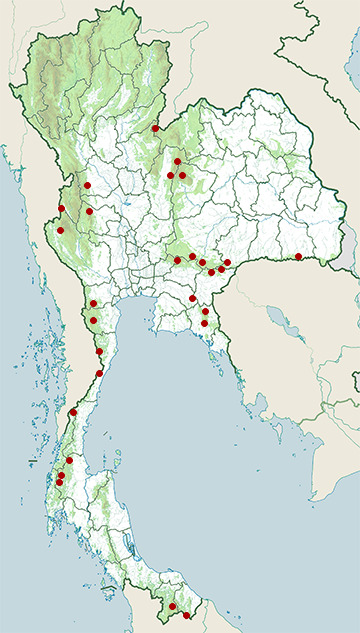
- Bang Lang National Park
- Dong Yai Wildlife Sanctuary
- Hala-Bala Wildlife Sanctuary
- Huai Kha Khaeng Wildlife Sanctuary
- Huai Yang Waterfall National Park
- Kaeng Krachan National Park
- Kaeng Krung National Park
- Khao Ang Rue Nai Wildlife Sanctuary
- Khao Khitchakut National Park
- Khao Laem National Park
- Khao Soi Dao Wildlife Sanctuary
- Khao Sok National Park
- Khao Yai National Park
- Khlong Lan National Park
- Khlong Saeng Wildlife Sanctuary
- Kui Buri National Park
- Mae Nam Phachi Wildlife Sanctuary
- Nam Nao National Park
- Pang Sida National Park
- Phanom Dong Rak Wildlife Sanctuary
- Phu Khiao Wildlife Sanctuary
- Phu Suan Sai National Park
- Sadeth Naikrom - Krom Luang Wildlife Sanctuary
- Ta Phraya National Park
- Tat Mok National Park
- Thap Lan National Park
- Thung Yai Naresuan Wildlife Sanctuary
- Wang Nam Khiao District, Nakhon Ratchasima
